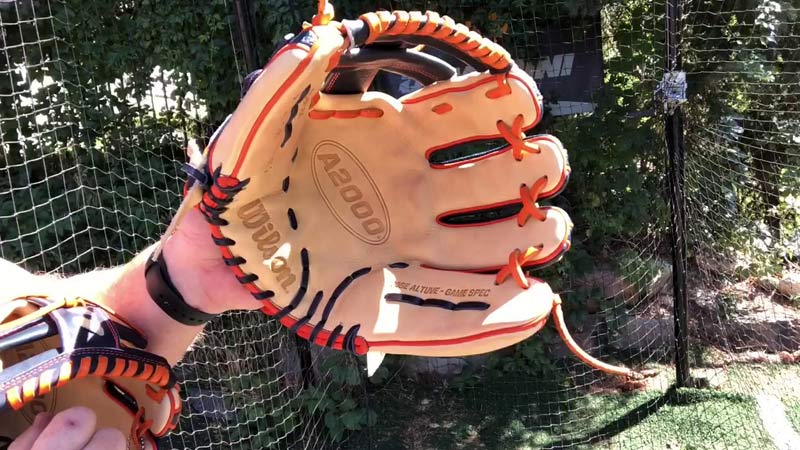Breaking in a Wilson A2000 Infield Glove is an art, a process that transforms a stiff new piece of leather into a personalized, game-ready extension of your hand.
The journey to this glove’s perfect form involves patience, care, and a few well-honed techniques.
Discover how to break in a Wilson a2000 infield glove, ensuring your glove becomes a seamless part of your game.
From traditional methods to unconventional approaches, this guide unveils various tactics to expedite the break-in process without compromising the glove’s durability.
Whether you’re a seasoned player or a rookie navigating this ritual for the first time, this comprehensive guide will lead you through the intricate steps of breaking in your Wilson A2000 Infield Glove. So, stay focused.
Why Break in Your Glove?
Breaking in a baseball glove is crucial for player comfort and performance. New gloves are stiff, making it challenging to catch and control the ball.
Breaking it in involves softening the leather, molding it to your hand, and creating a pocket for better ball retention.
Techniques include using glove oil, pounding the pocket with a mallet, or simply playing catch to shape the glove.
This process customizes the fit, making it easier to catch, throw, and control the ball, ultimately enhancing a player’s confidence and performance on the field.
A well-broken-in glove becomes an extension of the player’s hand, ensuring better plays and a more enjoyable game.
How to Break in a Wilson A2000 Infield Glove: Step-by-Step Guide
Breaking in a Wilson A2000 Infield Glove is a rite of passage for many ballplayers. Here’s a step-by-step guide to achieve that perfect game-ready feel:
Condition the Leather
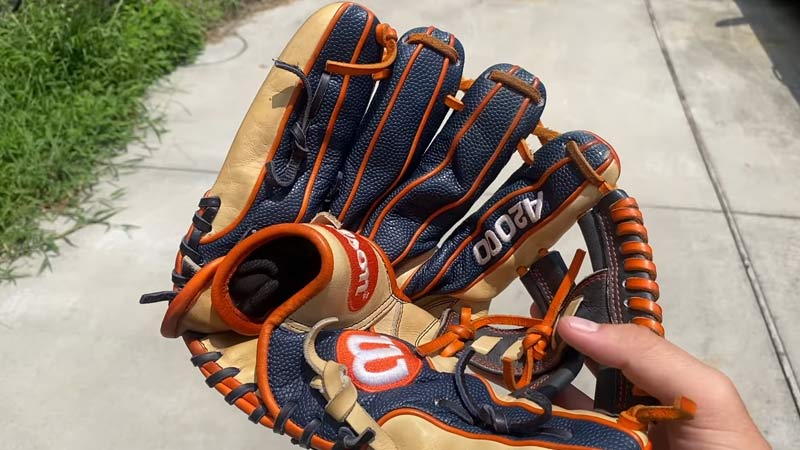
Start by applying a small amount of glove oil or a specialized leather conditioner to the glove.
Gently rub it into the pocket, laces, and the entire surface. This softens the leather, making it more pliable for shaping.
Work the Glove
Using a mallet or your fist, work the pocket by repeatedly striking it. Focus on the center of the pocket to create a deeper, more defined shape.
This process helps form a natural catch area while maintaining the glove’s structure.
Shape and Mold
Form the glove to your hand by repeatedly opening and closing it. Bend the fingers, fold the thumb, and shape the glove around a ball when not in use.
Some players also tie a ball or use a belt to create a ball-shaped pocket and keep it wrapped overnight.
Game-Like Break-In
To finish the process, take the glove to the field. Play catch or take part in batting practice.
Using the glove in game-like situations helps it adapt to catching and fielding, allowing for a more personalized break-in.
Remember, breaking in a glove takes time and patience.
With consistent conditioning and proper use, your Wilson A2000 will form into a trusty extension of your hand, ready for infield action
How Long to Break in Wilson A2000?
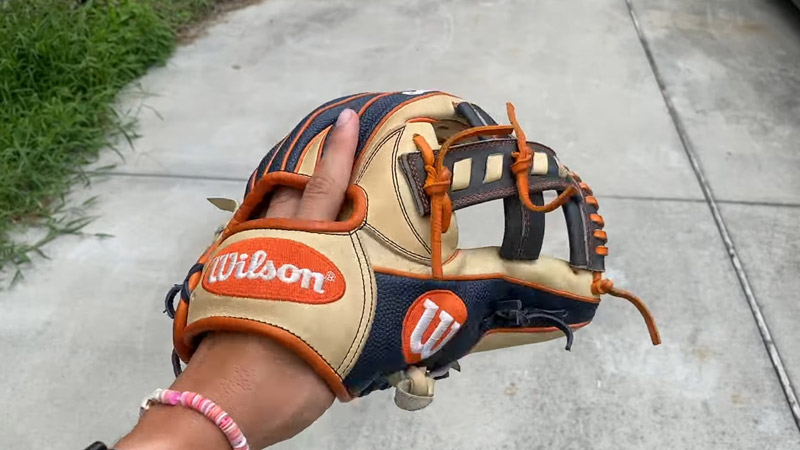
Breaking in a Wilson A2000 glove can vary in duration, influenced by factors like leather stiffness and the amount of play. Here’s an approximate breakdown:
Initial Feel
Out of the box, the A2000 might feel stiff and require some effort to open and close.
However, due to its high-quality Pro Stock leather, it tends to break in quicker than other gloves. Initially, it might take a few weeks of regular use to start feeling comfortable.
Conditioning Impact
Applying glove oil or conditioner expedites the softening process, potentially cutting down break-in time.
Conditioning helps the leather become more supple, reducing the stiffness and facilitating easier closure of the glove around the ball.
Player Usage
The more frequently you use the glove, the faster it breaks in.
Regular practice sessions, playing catch, and fielding grounders during training sessions contribute to the glove conforming to your hand’s shape and the ball’s contours, speeding up the process.
Customization and Adaptation
A fully broken-in A2000 might take several months of consistent use to achieve that perfectly game-ready feel.
The pocket will deepen and form a shape that best suits your playing style and position, offering an excellent balance of structure and flexibility for optimal performance.
Remember, individual preferences and playing habits can influence the break-in time.
Some players might find their A2000 game-ready in a matter of weeks, while others might take a few months to achieve the desired feel and fit.
Tips for Quick Breaking in Wilson A2000
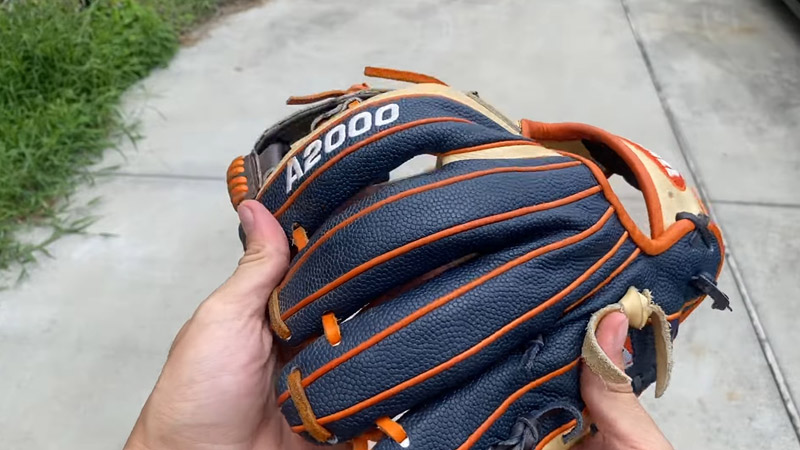
You have already learned the best way to break in 2000. Now, let’s talk about some effects of Wilson’s a2000 break-in.
For those seeking a rapid break-in process for the Wilson A2000 glove, there are a few techniques to expedite the softening and shaping of the leather:
Heat and Moisture Technique
One method involves heating the glove slightly to make the leather more pliable. Use a hairdryer on a low setting to warm the glove, then apply a small amount of conditioner.
Follow this by placing a dampened (not soaked) sponge or towel inside the pocket and wrapping the glove with a rubber band to help mold it to the desired shape.
Glove Steaming
Professional glove steaming services or even DIY steaming can significantly accelerate the break-in process.
This method involves using steam to soften the leather, making it more flexible and easier to shape. However, caution is necessary to avoid damaging the glove with excessive heat.
Progressive Use of Conditioner
Applying leather conditioner in small amounts frequently can speed up the softening process.
However, be cautious not to over-saturate the glove, as it can cause the leather to lose its structure.
Frequent Shaping and Manipulation
Consistently work the glove by repeatedly opening and closing it, flexing the fingers, and forming the pocket around a ball when not in use.
This regular manipulation helps the glove adapt more quickly to the desired shape.
While these methods might hasten the break-in process, it’s crucial to be mindful of not rushing it excessively, as aggressive techniques can potentially compromise the glove’s durability or affect its performance in the long run
Alternative Methods to Wilson Glove Break-in
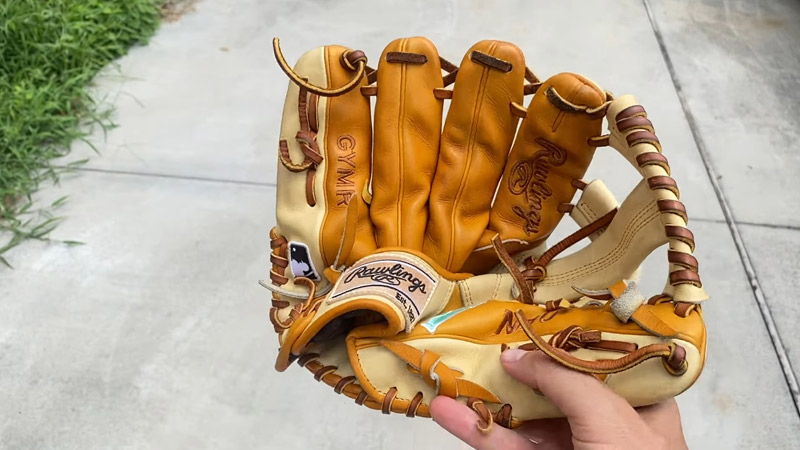
When traditional break-in methods don’t suit your preference or timeframe, there are alternative approaches to breaking in a Wilson glove:
Freezing Method
A unique technique involves placing the glove in a plastic bag and sealing it tightly. Put it in the freezer overnight. The cold temperature makes the leather more pliable.
After taking it out, let it gradually return to room temperature, then condition the glove while it’s still slightly cold to expedite the softening process.
Hot Water Bath
Submerging the glove in hot water (not boiling) for a few minutes can soften the leather.
Be cautious not to soak it entirely, as excessive water exposure might damage the glove. Once softened, shape it, then let it air dry.
Steam Rooms or Saunas
In a controlled environment, exposing the glove to steam or sauna-like conditions might accelerate the softening process. However, exercise caution to prevent excessive heat or moisture damage.
Natural Elements Assistance
Some players experiment with leaving the conditioned glove in the sun or in a warm, dry area for short periods to help soften the leather faster.
However, this method should be used sparingly to avoid damaging the glove.
Use of a Leather Softening Chamber
Some sports equipment stores offer specialized chambers or conditioning rooms equipped with controlled heat and humidity.
These conditions help soften the leather faster and more uniformly. The gloves are placed in these chambers for a specific period, reducing break-in time significantly.
Mechanical Break-In Tools
Utilizing mechanical aids designed specifically for glove break-ins, like a glove mallet or a glove stretching tool, can hasten the process.
These tools allow you to manipulate and stretch the leather more precisely than manual methods, reducing the time required for the glove to conform to your hand.
Glove Manipulation Devices
Some newer innovations in glove break-in involve using glove manipulation devices that gently flex and shape the glove without causing undue stress on the leather.
These devices work to soften the glove quickly without compromising its integrity.
Each alternative method comes with its own set of precautions and considerations.
It’s important to follow manufacturer guidelines and exercise caution to prevent potential damage to the glove while expediting the break-in process.
FAQs
How to break in a Wilson A2000?
Breaking in a Wilson A2000 involves several steps. Begin by applying a small amount of glove conditioner to the leather, focusing on the pocket and creases.
Use a mallet or repeatedly catch a ball in the pocket to soften the glove.
How to break in Wilson A2000?
To break in a Wilson A2000 glove, start by gently applying a specialized glove conditioner.
Work the conditioner into the leather, paying extra attention to areas like the pocket, web, and seams. Follow up with repeated use and ball-catching to soften the glove and More Glove Care Insights.
What’s the best way to soften a Wilson A2000 glove?
Softening a Wilson A2000 involves using a high-quality leather conditioner. Apply a small amount to the glove’s pocket and flex points.
Additionally, repeatedly play catch, focusing on catching balls in the pocket to expedite the softening process.
How long does it take to break in a Wilson A2000?
The time needed to break in a Wilson A2000 can vary.
With regular use, conditioning, and ball-catching exercises, it can take a few weeks to a few months to achieve the desired level of softness and flexibility in the glove.
Are there specific techniques for breaking in an A2000 for infield play?
Infield gloves like the Wilson A2000 benefit from a more defined and structured pocket.
Focus on conditioning the glove around the pocket and thumb area, ensuring it’s pliable yet offers enough structure for quick ball retrieval and release.
Regular use tailored to infield movements aids in breaking it in perfectly.
Wrapping Up
Breaking in a Wilson A2000 Infield Glove is more than just a process—it’s a ritual that melds craftsmanship with personalization.
Through patience and strategic methods, this tool of the trade evolves from stiff leather to a supple, game-ready asset.
Your dedication to conditioning, shaping, and using the glove will forge a piece uniquely suited to your play.
Embrace the journey, as the glove gradually transforms into a natural extension of your hand, offering reliability and confidence on the field. Thank you for your support.

